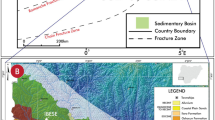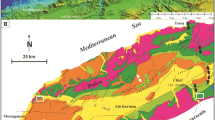Abstract
Both radiocarbon and optically stimulated luminescence (OSL) dating methods were applied to test their suitability for establishing a chronology of arid-zone lacustrine sediments using a 5.88-m-long core drilled from Lake Ulaan, southern Mongolia. Although the radiocarbon and OSL ages agree in some samples, the radiocarbon ages are older than the corresponding OSL ages at the 550-cm depth horizon (late Pleistocene) and in the 100–300-cm interval (early to late Holocene). In the early to late Holocene, radiocarbon ages are consistently older than OSL ages by 4,100–5,800 years, and in the late Pleistocene by 2,700–3,000 years. Grain-size analysis of early to late Holocene sediments and one late Pleistocene sediment sample (550-cm depth) indicates that eolian processes were the dominant sediment-transport mechanism. Also, two late Pleistocene sediments samples (from 400- to 500-cm depths) are interpreted to have been deposited by both eolian and glaciofluvial processes. Accordingly, the radiocarbon ages that were older than the corresponding OSL ages during the Holocene seem to have been a consequence of the influx of 14C-deficient carbon delivered from adjacent soils and Paleozoic carbonate rocks by the westerly winds, a process that is also active today. In addition to the input of old reworked carbon by eolian processes, the late Pleistocene sediments were also influenced by old carbon delivered by deglacial meltwater. The results of this study suggest that when eolian sediment transport is suspected, especially in lakes of arid environments, the OSL dating method is superior to the radiocarbon dating method, as it eliminates a common ‘old-carbon’ error problem.





Similar content being viewed by others
References
Aravena R, Warner B, MacDonald GM, Hanf KI (1992) Carbon isotope composition of lake sediments in relation to lake productivity and radiocarbon dating. Quat Res 37:333–345
Bøtter-Jensen L, Bulur E, Duller GAT, Murray AS (2000) Advances in luminescence instrument systems. Radiat Meas 32:523–528
Clayton L, Moran SR (1982) Chronology of late Wisconsin glaciations in middle North America. Quat Sci Rev 1:55–82
Fowler AJ, Gillespie R, Hedges REM (1986) Radiocarbon dating of sediments. Radiocarbon 28:441–450
Grimm EC, Maher LJ Jr, Nelson DM (2009) The magnitude of error in conventional bulk-sediment radiocarbon dates from central North America. Quat Res 72:301–308
Grunert J, Lehmkuhl F, Walther M (2000) Paleoclimatic evolution of the Uvs Nuur basin and adjacent areas (Western Mongolia). Quat Int 65/66:171–192
Jones KPN, McCave IN, Patel PD (1988) A computer interfaced sedigraph for modal size analysis of fine-grained sediment. Sedimentology 35:163–172
Karrow PF, Anderson TW (1975) Palynological study of lake sediment profiles from southwestern New Brunswick: discussion. Can J Earth Sci 12:1808–1812
Lee MK, Lee YI, Lim HS, Lee JI, Yoon HI (2009) Climatic changes during the Holocene and late Pleistocene recorded in Ulaan Lake sediments, Mongolia. In: Proceedings the 64th annual meeting geological society Korea 64, p 60
Liu XJ, Lai ZP, Fan QS, Long H, Sun YJ (2010) Timing for high lake levels of Qinghai Lake in the Qinghai-Tibetan Plateau since the last interglaciation based on quartz OSL dating. Quat Geochronol 5:218–222
Long H, Lai ZP, Wang NA, Zhang JR (2011) A combined luminescence and radiocarbon dating study of Holocene lacustrine sediments from arid northern China. Quat Geochronol 6:1–9
MacDonald GM, Beuken RP, Kieser WE, Vitt DH (1987) Comparative radiocarbon dating of terrestrial plant macrofossils and aquatic moss from the “ice-free corridor” of western Canada. Geology 15:837–840
Murray AS, Wintle AG (2000) Luminescence dating of quartz using an improved single-aliquot regenerative-dose protocol. Radiat Meas 32:57–73
Murray AS, Wintle AG (2003) The single aliquot of regenerative dose protocol: potential for improvements in reliability. Radiat Meas 37:377–381
Murray AS, Marten R, Johnston A, Martin P (1987) Analysis for naturally occurring radionuclides at environmental concentrations by gamma spectrometry. J Radioanal Nucl Chem 115:263–288
Nambudiri EMV, Teller JT, Last WM (1980) Pre-quaternary microfossils—a guide to errors in radiocarbon dating. Geology 8:123–126
Olley JM, Murray AS, Roberts RG (1996) The effects of disequilibria in the uranium and thorium decay chains on burial dose rates in fluvial sediments. Quat Sci Rev 15:751–760
Olsson IU (1986) Radiometric dating. In: Berglund BE (ed) Handbook of Holocene palaeoecology and palaeohydrology. John Wiley & Sons, Chichester, pp 273–312
Prescott JR, Hutton JT (1988) Cosmic ray and gamma ray dosimetry for TL and ESR. Int J Radiat Appl Instrum Part D Nucl Tracks Radiat Meas 14:223–227
Prescott JR, Hutton JT (1994) Cosmic ray contributions to dose rates for luminescence and ESR dating: large depths and long-term time variations. Radiat Meas 23:497–500
Ramsey CB (2009) Bayesian analysis of radiocarbon dates. Radiocarbon 51:337–360
Rees-Jones J (1995) Optical dating of young sediments using fine-grain quartz. Anc TL 13:9–14
Reimer PJ, Baillie MGL, Bard E, Bayliss A, Beck JW, Blackwell PG, Ramsey CB, Buck CE, Burr GS, Edwards RL, Friedrich M, Grootes PM, Guilderson TP, Hajdas I, Heaton TJ, Hogg AG, Hughen KA, Kaiser KF, Kromer B, McCormac FG, Manning SW, Reimer RW, Richards DA, Southon JR, Talamo S, Turney CSM, van der Plicht J, Weyhenmeyer CE (2009) IntCal09 and marine09 radiocarbon age calibration curves, 0–50,000 years CAL BP. Radiocarbon 51:1111–1150
Riggs AC (1984) Major carbon-14 deficiency in modern snail shells from southern Nevada springs. Science 224:58–61
Schidlowski M, Hayes JM, Kaplan IR (1983) Isotopic inferences of ancient biochemistries: carbon, sulfur, hydrogen and nitrogen. In: Schopf JW (ed) Earth’s earliest biosphere: its origin and evolution. Princeton University Press, Princeton, pp 149–186
Sevastyanov DV, Dorofeyk NI (2005) A short review: limnological and paleolimnological researches in Mongolia carried out by joint Russian-Mongolian expeditions. J Mt Sci 2:86–90
Shen Z, Mauz B, Lang A, Bloemendal J, Dearing J (2007) Optical dating of Holocene lake sediments: elimination of the feldspar component in fine silt quartz samples. Quat Geochronol 2:150–154
Stokes S, Gaylord DR (1993) Optical dating of Holocene dune sands in the Ferris Dune Field, Wyoming. Quat Res 39:274–281
Stokes S, Thomas DSG, Washington R (1997) Multiple episodes of aridity in southern Africa since the last interglacial period. Nature 388:154–158
Sutherland DG (1980) Problems of radiocarbon dating in newly deglaciated terrain: examples from the Scottish Lateglacial. In: Lowe JJ, Gray JM, Robinson JE (eds) Studies in the Lateglacial of north-west Europe. Pergamon, Oxford, pp 139–149
Telford RJ, Heegaard E, Birks HJB (2004) The intercept is a poor estimate of a calibrated radiocarbon age. Holocene 14:296–298
Turner JV, Fritz P, Karrow PF, Warner BG (1983) Isotopic and geochemical composition of marl lake waters and implications for radiocarbon dating of marl lake sediments. Can J Earth Sci 20:599–615
Wintle AG, Murray AS (2006) A review of quartz optically stimulated luminescence characteristics and their relevance in single-aliquot regeneration dating protocols. Radiat Meas 41:369–391
Zhao H, Lu Y, Wang C, Chen J, Liu J, Mao H (2010) ReOSL dating of aeolian and fluvial sediments from Nihewan Basin, northern China and its environmental application. Quat Geochronol 5:159–163
Zimmerman DW (1971) Thermoluminescence dating using fine grains from pottery. Archaeometry 13:29–52
Acknowledgments
This work was supported by the Korea Polar Research Institute Project (PE10010), the Korea Meteorological Administration Research and Development Program (RACS 2010-3007, PN10040), and partly by a SNU-SEES BK21 program.
Author information
Authors and Affiliations
Corresponding author
Rights and permissions
About this article
Cite this article
Lee, M.K., Lee, Y.I., Lim, H.S. et al. Comparison of radiocarbon and OSL dating methods for a Late Quaternary sediment core from Lake Ulaan, Mongolia. J Paleolimnol 45, 127–135 (2011). https://doi.org/10.1007/s10933-010-9484-7
Received:
Accepted:
Published:
Issue Date:
DOI: https://doi.org/10.1007/s10933-010-9484-7




